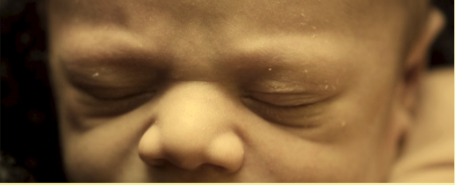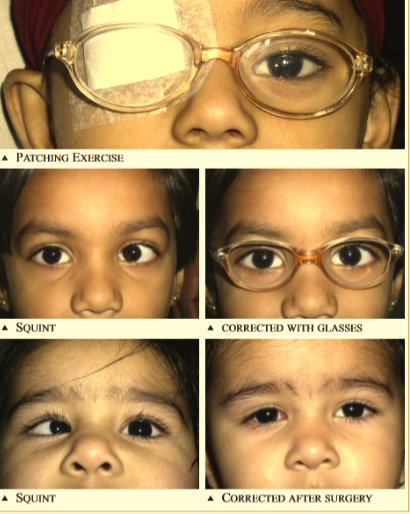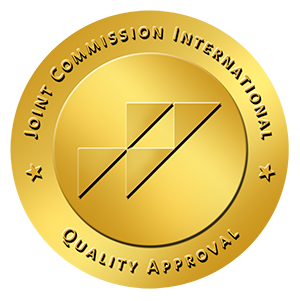PEDIATRIC OPTHALMOLOGY

New-borns And Common Eye Disorders Among Them
Arrival of a new-born brings happiness to the entire family. The baby becomes the cynosure of all eyes. But for the parents, it is important to look beyond the color of their little one’s eyes. They should examine the baby’s eyes to ensure there aren’t any gross abnormalities.
Any eye abnormality detected at birth should be immediately brought to the notice of an eye specialist. A neonate’s eyes are slightly smaller than adults. It takes only two years for a baby’s eyes to develop to adult size.
Eye infection in newborns are common. Between birth till four weeks, a baby can suffer neonatal conjunctivitis. This infection needs to be controlled by using appropriate antibiotics.
Continuous watering from one or both eyes, accompanied by copious discharge is a frequent problem in babies. During the first four weeks of a baby’s life, tear secretions are less than normal. Any watering from eyes during this period is abnormal. Discharge and watering from the eyes at birth suggests infection, while the same symptoms in a three week or older baby, suggest failure of tear ducts to open.
An examination is required to make a diagnosis. If watering does not stop by four months, probing the passage may be required to open them. Delay in treatment may result in a major surgery later on to make alternate passage.
Buphthalmos or infantile glaucoma is a baby born with ‘Kala Motia’ and symptoms include watering and sensitivity to light. The eye is bluish and big in size due to increased pressure in the eye. It needs treatment with drops followed by surgery. Repeated examinations may be done under anaesthesia. Failure to treat leads to permanent damage to optic nerve and complete blindness.
The cornea should appear normal at this stage. An opacity or raised mass on the front part of eye is abnormal. It could be a dermoid, a benign but cosmetic situation that is treatable with surgery.
Any obvious abnormality of the eyelid should be taken seriously. It is not often, but a child may have a congenital coloboma, a condition in which a part of eyelid may be missing. Normally lids cover upper 1-2mm of cornea. In case it covers more than that, it’s a condition called drooping of the eyelid or Ptosis. The lid can be lifted up with surgery.
It is important to make assessment of the alignment of the eyes and vision. Parents must keep an eye on baby’s eyes. Early identification and treatment is important and can actually change the way your baby looks at the world.

Strasbismus is common parlance also known as squint or 'Teer' is not uncommon. It affects 2-5% of all children. The condition is brought about by an imbalance of the muscular forces moving the eye.
Normally both the eyes move equally in conjunction with each other for all direction of gaze and there is no misalignment. The exact cause why squint develops in an otherwise normal child cannot be determined. However, there is a higher chance of developing squint if there is family history of such disturbances. In children, the presence of refractive errors especially if asymmetric between the two eyes, can also lead to the development of squint. Other causes in children may be following trauma or be associated with mental retardation, delayed development or associated with other systemic abnormalities in certain syndromes. In adults major reasons why a squint develops may be due to injury, associated with hypertension and diabetes, brain tumors, thyroid disturbances or associated with infections.
The diagnosis of squint is arrived at after a thorough examination by a Strasbismus specialist. Sometimes young children who have a wide nasal bridge are brought to the ophthalmologists because the parents feel that the child's squint when looking to one side. This is a false appearance, also known as 'Pseudo Strasbismus', and will disappear as the child grows and the facial asymmetry improves over time.
The treatment of squint depends upon the type of deviation. A thorough evaluation should be carried out to determine the type of squint. This is best done by an ophthalmologist, specifically trained and experienced in handling squint cases. In children the evaluation includes a refraction done under cycloplegia which is basically a temporary paralysis of the eye muscles responsible for accommodation. This is achieved by instilling ointment or drops in the eye. The effect of these medicines may last from a couple of days to a fortnight or so.
In some children correction of the refractive error alone will correct the squint. This is known as 'Accomodative Squint'. These children will be slowly weaned away from spectacles with time. Some cases which have a 'Latent Squint', i.e, the squint is not present all the time may benefit from exercises. In all children, lazy eye must be diagnosed and treated in the beginning.
Most children who have a 'Manifest Squint' which does not get corrected with spectacles will need surgery. The results of surgery vary with type of squint. For most squints which appear early in life, surgery provides excellent results and long term success. Early surgery helps to avoid dense Amblyopia and is must for helping normalize visual development.
It is very important to diagnose and treat early. Myths such as waiting till the child attains maturity before management of squint must be dispelled. If your child has squint don't ignore it. Get it thoroughly evaluated and treated in time.
Any eye abnormality detected at birth should be immediately brought to the notice of an eye specialist. A neonate’s eyes are slightly smaller than adults. It takes only two years for a baby’s eyes to develop to adult size.
Eye infection in newborns are common. Between birth till four weeks, a baby can suffer neonatal conjunctivitis. This infection needs to be controlled by using appropriate antibiotics.
Continuous watering from one or both eyes, accompanied by copious discharge is a frequent problem in babies. During the first four weeks of a baby’s life, tear secretions are less than normal. Any watering from eyes during this period is abnormal. Discharge and watering from the eyes at birth suggests infection, while the same symptoms in a three week or older baby, suggest failure of tear ducts to open.
An examination is required to make a diagnosis. If watering does not stop by four months, probing the passage may be required to open them. Delay in treatment may result in a major surgery later on to make alternate passage.
Buphthalmos or infantile glaucoma is a baby born with ‘Kala Motia’ and symptoms include watering and sensitivity to light. The eye is bluish and big in size due to increased pressure in the eye. It needs treatment with drops followed by surgery. Repeated examinations may be done under anaesthesia. Failure to treat leads to permanent damage to optic nerve and complete blindness.
The cornea should appear normal at this stage. An opacity or raised mass on the front part of eye is abnormal. It could be a dermoid, a benign but cosmetic situation that is treatable with surgery.
Any obvious abnormality of the eyelid should be taken seriously. It is not often, but a child may have a congenital coloboma, a condition in which a part of eyelid may be missing. Normally lids cover upper 1-2mm of cornea. In case it covers more than that, it’s a condition called drooping of the eyelid or Ptosis. The lid can be lifted up with surgery.
It is important to make assessment of the alignment of the eyes and vision. Parents must keep an eye on baby’s eyes. Early identification and treatment is important and can actually change the way your baby looks at the world.
Keep An Eye On Your Child's Eye
Gagan is a bright student, but lately he has been making silly mistakes while copying matter from the black board. His teacher also noticed that he often moves closer to the blackboard while doing so.
The teacher apprised Gagan’s parents of this problem, and they consulted an eye specialist without any delay. The examination showed that Gagan had poor vision, which could be corrected by spectacles.
The doctor prescribed the right glasses for him, and Gautam was back to his previous best in the class! It’s crucial that poor vision in children is detected in time. If the correction of vision through prescription glasses is delayed, it may take the child longer than usual to recover the vision completely. That’s why it is important that the parents and teachers keep an eye on this aspect and are sensitive to symptoms.
If a child shows a tendency to move closer to the television while watching it, gets irritated while viewing distant objects, makes error in reading numbers of moving cars, struggles to see things clearly, suffers from bouts of headaches, then something could be wrong with his vision. In this case, he should be taken to an eye specialist for a checkup immediately.
For children, it’s mandatory that the first prescription of glasses is given only after cycloplegic refraction. The term cycloplegic refraction refers to the assessment of an eye’s refractive error after lens accommodation has been paralyzed with cycloplegic eyedrops (to eliminate variability in optical power caused by a contracting lens).
A child has strong focusing power and he cannot relax his eyes completely for an accurate assessment of the number. Therefore, it is necessary that some drops be used to temporarily knock out the focusing mechanism, so that an accurate assessment of the required number can be procured. A few days after the cycloplegic refraction, the child has to undergo a re-examination for the final prescription of glasses. These drops lead to some temporary blurring of vision for a day or two, so the child may experience glares when out in the sun.
By and large, the acceptance of glasses by children is exceptionally good. However, at times, parents tend to be a little reluctant to their child using glasses. The parents should not make a fuss about their child wearing glasses. They should also make their child believe that he looks good in glasses, so that he doesn’t feel inferior to other kids. Another thing that the parents must know is that while the child is growing up and gaining height, there is a possibility of a change in number, This calls for regular checkups of vision, at least twice a year. So parents, make your child feel proud about his/her glasses. They will help him see the world better.
The doctor prescribed the right glasses for him, and Gautam was back to his previous best in the class! It’s crucial that poor vision in children is detected in time. If the correction of vision through prescription glasses is delayed, it may take the child longer than usual to recover the vision completely. That’s why it is important that the parents and teachers keep an eye on this aspect and are sensitive to symptoms.
If a child shows a tendency to move closer to the television while watching it, gets irritated while viewing distant objects, makes error in reading numbers of moving cars, struggles to see things clearly, suffers from bouts of headaches, then something could be wrong with his vision. In this case, he should be taken to an eye specialist for a checkup immediately.
For children, it’s mandatory that the first prescription of glasses is given only after cycloplegic refraction. The term cycloplegic refraction refers to the assessment of an eye’s refractive error after lens accommodation has been paralyzed with cycloplegic eyedrops (to eliminate variability in optical power caused by a contracting lens).
A child has strong focusing power and he cannot relax his eyes completely for an accurate assessment of the number. Therefore, it is necessary that some drops be used to temporarily knock out the focusing mechanism, so that an accurate assessment of the required number can be procured. A few days after the cycloplegic refraction, the child has to undergo a re-examination for the final prescription of glasses. These drops lead to some temporary blurring of vision for a day or two, so the child may experience glares when out in the sun.
By and large, the acceptance of glasses by children is exceptionally good. However, at times, parents tend to be a little reluctant to their child using glasses. The parents should not make a fuss about their child wearing glasses. They should also make their child believe that he looks good in glasses, so that he doesn’t feel inferior to other kids. Another thing that the parents must know is that while the child is growing up and gaining height, there is a possibility of a change in number, This calls for regular checkups of vision, at least twice a year. So parents, make your child feel proud about his/her glasses. They will help him see the world better.

SQUINT- An Introduction
Strasbismus is common parlance also known as squint or 'Teer' is not uncommon. It affects 2-5% of all children. The condition is brought about by an imbalance of the muscular forces moving the eye.
Normally both the eyes move equally in conjunction with each other for all direction of gaze and there is no misalignment. The exact cause why squint develops in an otherwise normal child cannot be determined. However, there is a higher chance of developing squint if there is family history of such disturbances. In children, the presence of refractive errors especially if asymmetric between the two eyes, can also lead to the development of squint. Other causes in children may be following trauma or be associated with mental retardation, delayed development or associated with other systemic abnormalities in certain syndromes. In adults major reasons why a squint develops may be due to injury, associated with hypertension and diabetes, brain tumors, thyroid disturbances or associated with infections.
SQUINT- Diagnosis
The diagnosis of squint is arrived at after a thorough examination by a Strasbismus specialist. Sometimes young children who have a wide nasal bridge are brought to the ophthalmologists because the parents feel that the child's squint when looking to one side. This is a false appearance, also known as 'Pseudo Strasbismus', and will disappear as the child grows and the facial asymmetry improves over time.
SQUINT- Treatment
The treatment of squint depends upon the type of deviation. A thorough evaluation should be carried out to determine the type of squint. This is best done by an ophthalmologist, specifically trained and experienced in handling squint cases. In children the evaluation includes a refraction done under cycloplegia which is basically a temporary paralysis of the eye muscles responsible for accommodation. This is achieved by instilling ointment or drops in the eye. The effect of these medicines may last from a couple of days to a fortnight or so.
Spectacles & Exercise
In some children correction of the refractive error alone will correct the squint. This is known as 'Accomodative Squint'. These children will be slowly weaned away from spectacles with time. Some cases which have a 'Latent Squint', i.e, the squint is not present all the time may benefit from exercises. In all children, lazy eye must be diagnosed and treated in the beginning.
Surgery
Most children who have a 'Manifest Squint' which does not get corrected with spectacles will need surgery. The results of surgery vary with type of squint. For most squints which appear early in life, surgery provides excellent results and long term success. Early surgery helps to avoid dense Amblyopia and is must for helping normalize visual development.
It is very important to diagnose and treat early. Myths such as waiting till the child attains maturity before management of squint must be dispelled. If your child has squint don't ignore it. Get it thoroughly evaluated and treated in time.

International Quality Accreditated by
Joint Commission International, USA (JCI)
Online Appointment
Book Online Appointment and Save 10% on Online Payment.
